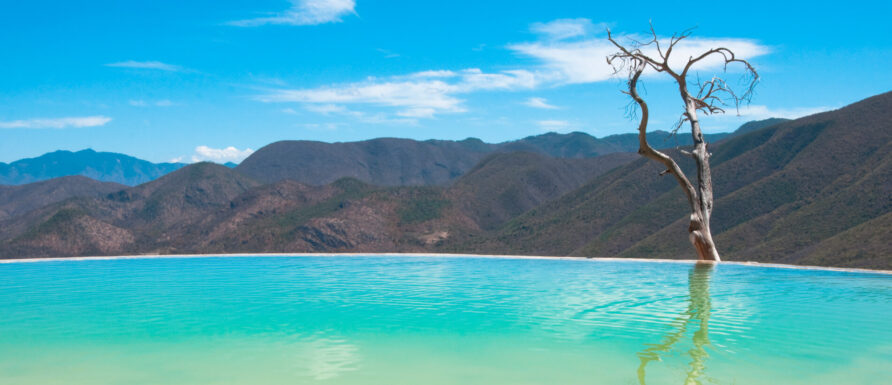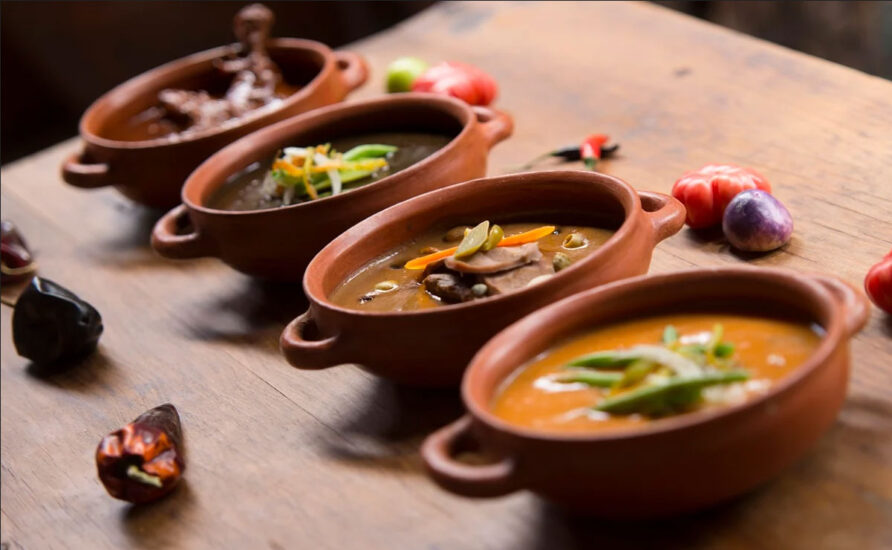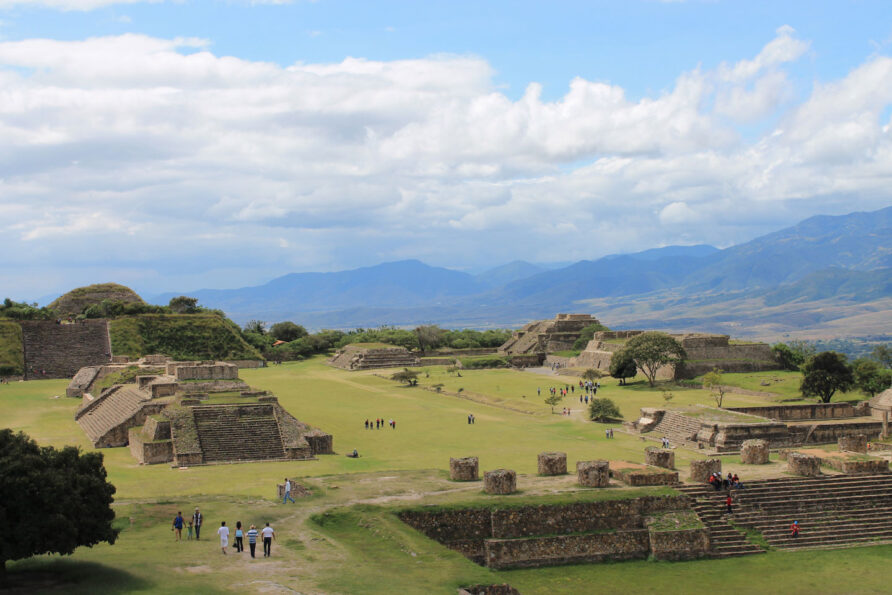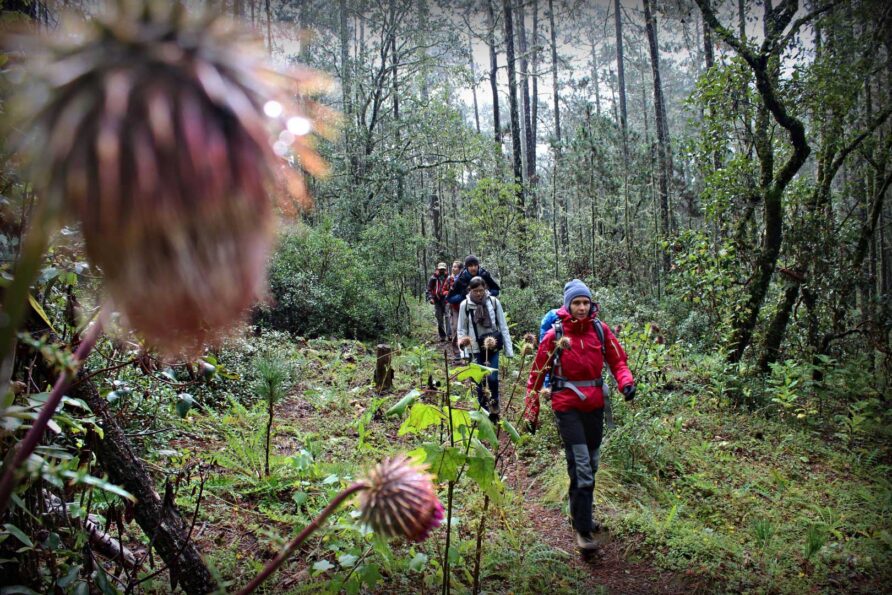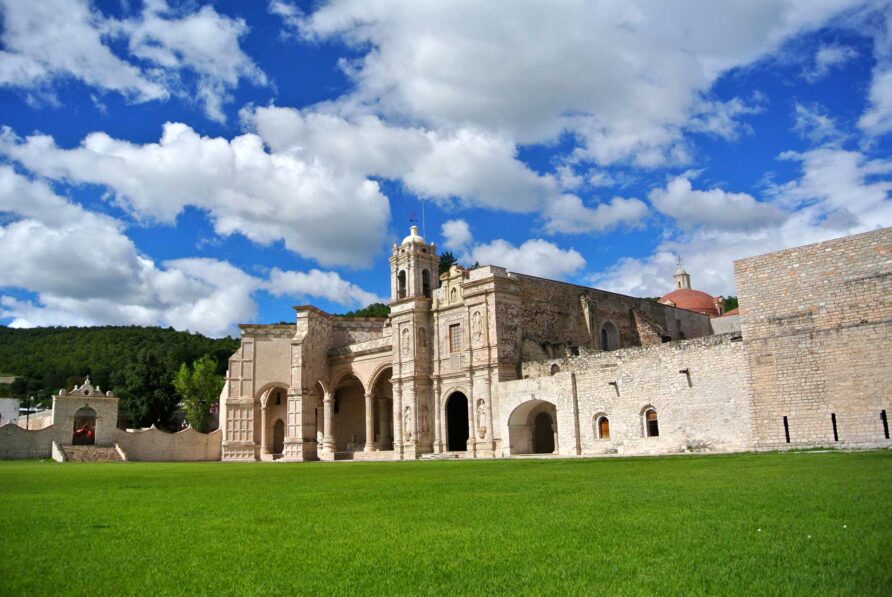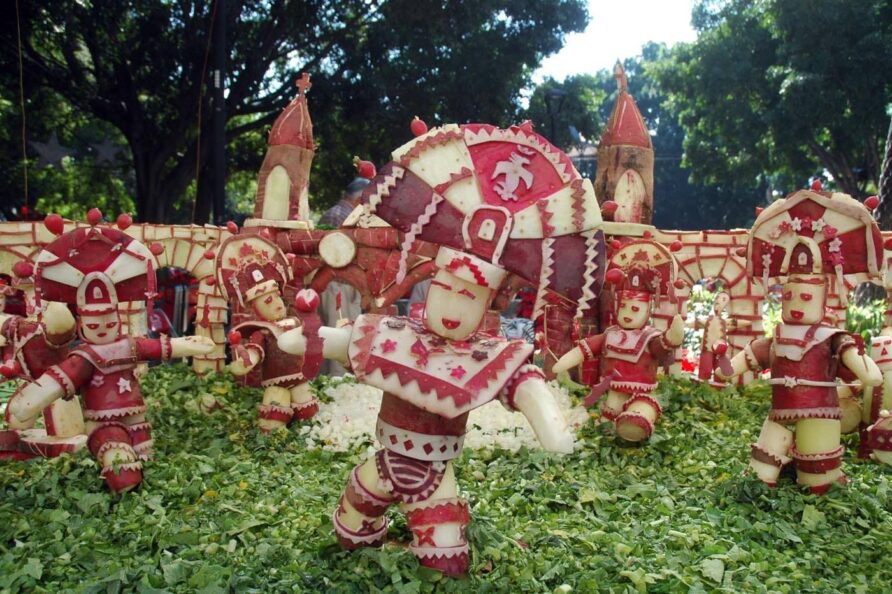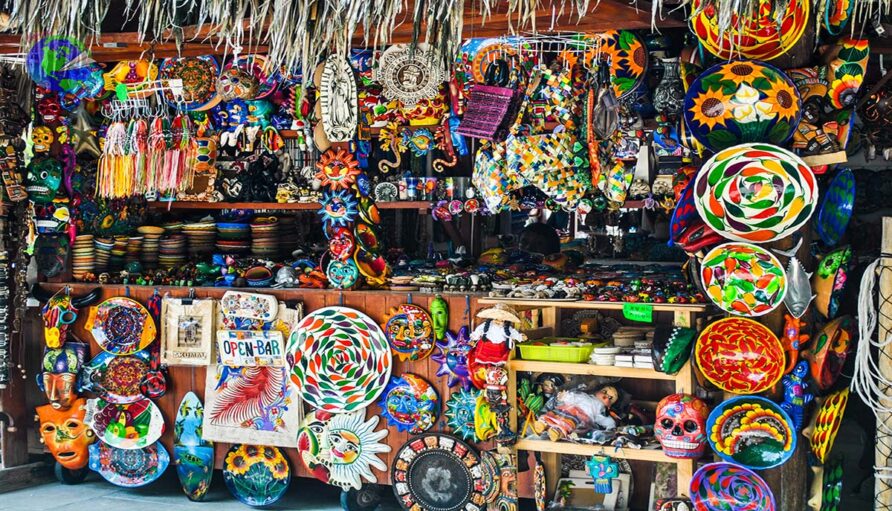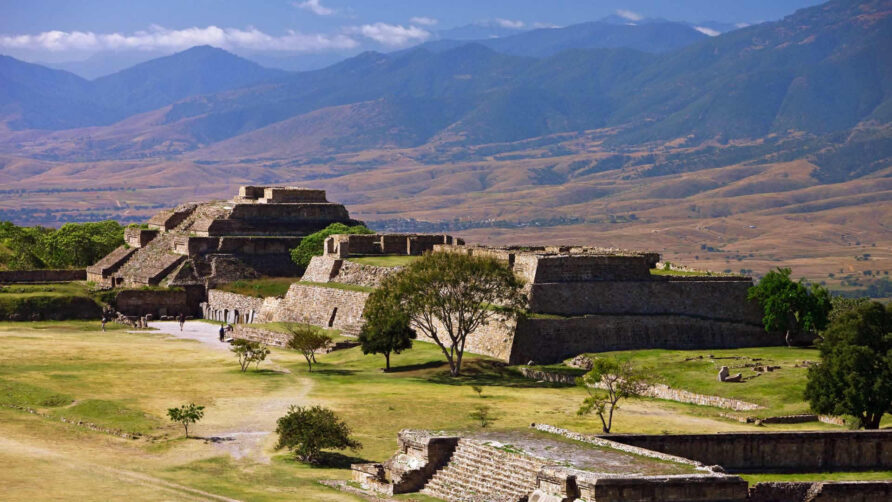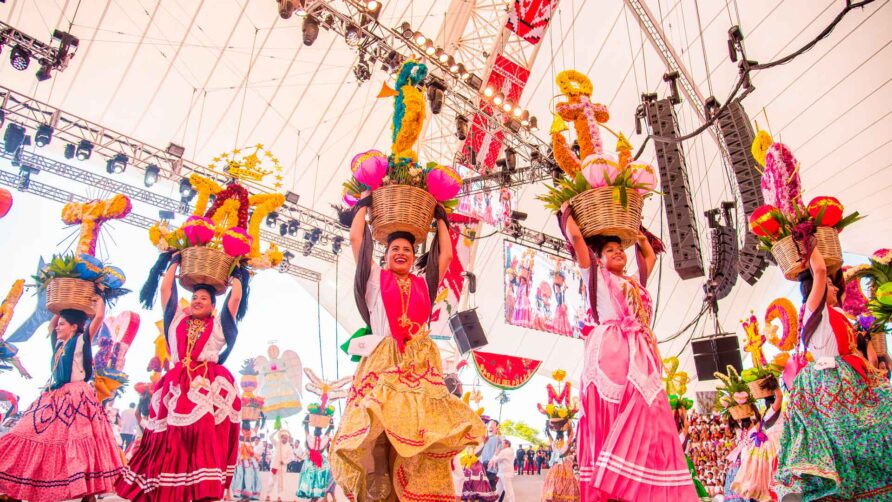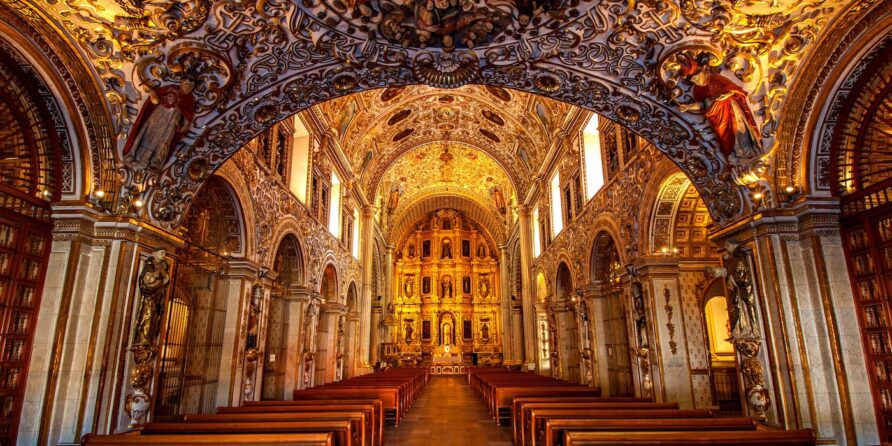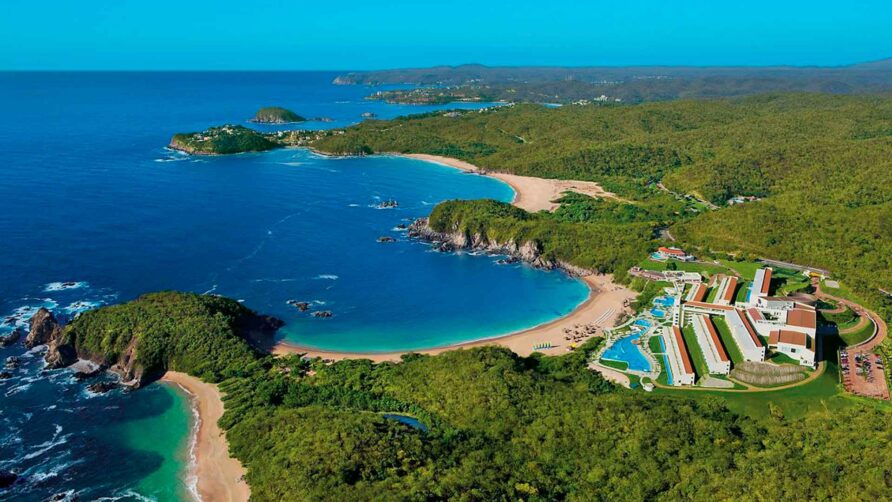Ro-House » Oaxaca " Around the city
Oaxaca City It is a destination that offers a great variety of tourist attractions and charms that leave anyone surprised. Upon arrival, the most common is to visit the historic center, the Santo Domingo Temple, the Macedonio Alcalá Tourist Walker, the gastronomic delights in the Benito Juárez market, the Basilica de la Soledad, among other attractions. And one of the places that you cannot miss is the archaeological zone of Monte Alban, which is approximately 30 minutes by car from the historic center.
However, there are other places that are also worth knowing and are in the surroundings of the city. For this reason we recommend the following tourist routes.

Surroundings of Oaxaca de Juárez

Route to Mitla
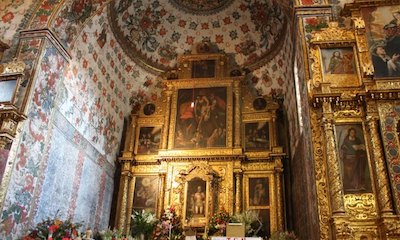
Tlacochahuaya. Religious complex dedicated to San Jerónimo built by the Dominicans in the 16th century. Its façade is baroque and inside it houses frescoes painted with cochineal and indigenous features. It contains some altarpieces by the famous indigenous painter, Juan de Aruebe, highlighting that of San Jerónimo, which has been considered one of the most outstanding works of the viceroyalty in Oaxaca, and a tubular organ dating from 1620 that has been restored and is working.
Dainzu. Small archaeological zone in which the interesting low-relief stone gallery stands out that shows ball players in pre-Hispanic outfits that are reminiscent of the figures found in Monte Albán. It features a well-preserved ball court and the Tomb of the Jaguar, with a jaguar head on top of the door. Built a few centuries before Monte Albán, in 600 BC
Teotitlán del Valle. The textile tradition in Teotitlán dates back to pre-Hispanic times. For centuries the inhabitants of this town have kept the tradition alive by making wool rugs on domestic looms, using natural dyes for their coloring. His designs range from frets, glyphs and codices to pictorial reproductions of Tamayo, Frida Kahlo, Miró, Matisse, Toledo and Picasso.
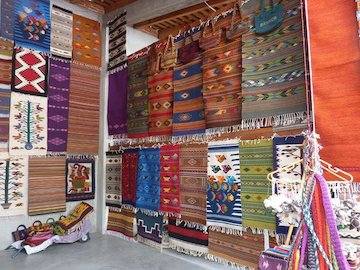
In the town there are more than 100 workshops where you can see the production of rugs, sarapes, ponchos, covers, bags and dresses. The community museum exhibits various pre-Hispanic objects, as well as pieces related to the making of rugs. The church is located in the central part of the town and is dedicated to the precious Blood of Christ, its construction began in 1581 and was completed in 1758. On its walls there are great idols engraved in stones, since the Spanish used stones from the ancient pre-Hispanic temples for its construction. On one side of the church there is a small archaeological zone.
In its surroundings you can visit “El Picacho”, a hill considered sacred and that offers a spectacular view of the Tlacolula valley; and the Piedra Azul Dam, a favorite place for those who like to watch birds.
Lambityeco. Its occupation occurred between 600 BC to 800 AD and its peak was between 700 and 750 AD. C., coinciding with the process of abandonment of Monte Albán. Headquarters of an important Zapotec commercial center, it was a salt production center that provided up to 90% of the salt consumed in the valley between 600 and 700 AD. The salt was extracted from the land called "tequezquite", located in the southern part of the site. The city comprises around 197 mounds of which only a small part has been explored. The site is notable for the extraordinary artistic quality of urns, engravings and mural paintings located in some tombs. The most important structures of the site are mounds 195 and 190, on the latter there are two stucco masks of the Zapotec god of rain “Cocijo”. Schedule: Monday to Sunday from 09:00 a.m. to 5:00 p.m.
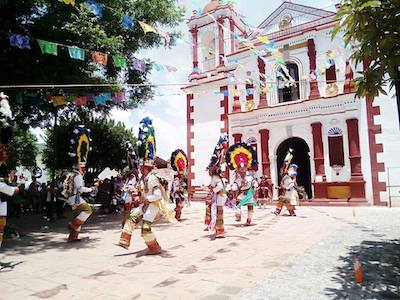
Santa Ana del Valle. The inhabitants of this place are weavers, they make wool textiles, sarapes, jorongos, using natural dyes. In its 18th century temple, a beautiful golden Baroque altarpiece and oil paintings are preserved. The Shan-Dany Community Museum has four rooms where archeology, the Mexican Revolution, the making of textiles and the feather dance, a choreographic art commemorating the conquest, are addressed. It opens every day from 10:00 a.m. to 2:00 p.m. and from 3:00 p.m. to 6:00 p.m.
Tlacolula. Its Sunday market is famous, distinguished by its color and indigenous character, where all the merchants from the nearby communities come down to sell their products. It is worth visiting the Temple of the Assumption built by the Dominicans in the 17th century. It has one of the greatest jewels of Mexican Baroque art, the chapel dedicated to Santo Cristo de Tlacolula.
Yagul. Archaeological zone founded by the Zapotecs, contemporary to Mitla. It flourished as an urban center after the decline of Monte Albán (800 AD). The site is made up of three parts: the Fortress, located on the highest part of a hill, offers a panoramic view of the Tlacolula valley. The ceremonial center, with a huge artificial platform that brings together the main temples and palaces in stepped terraces. And the residential areas. The Ball Court, the largest in the Oaxacan region, stands out, as well as the Palace of the Six Patios, an enormous almost labyrinthine structure dedicated to the room of the chief, or chiefs, of the city. Schedule: Monday to Sunday from 09:00 to 17:00.
Mitla. Its name is of Nahuatl origin and means “Place of the Dead”. It is a Zapotec ceremonial center, residence of the ecclesiastical power. Its maximum growth and apogee occurred between 950 and 1521 AD. The harmony of its buildings and the proportion of its patios are highlighted by the extraordinary fretwork decoration of its walls, it is a unique representation in Mesoamerica. The frets are made up of thousands of polished stone tablets, crimped together without any mixture. There are five groups of buildings, surrounded by a fence of cacti, known as: Grupo del Sur, Grupo del Adobe, Grupo del Arroyo, Grupo de las Columnas and Grupo de la Iglesia. The first two are classified as ceremonial complexes, made up of mounds and central squares, the other three are classified as organized palaces with rooms around quadrangular courtyards. In the seventeenth century, the temple of San Pablo was built over the rooms of Patio C, with materials from old pre-Hispanic palaces. Schedule: Monday to Sunday from 08:00 to 17:00.
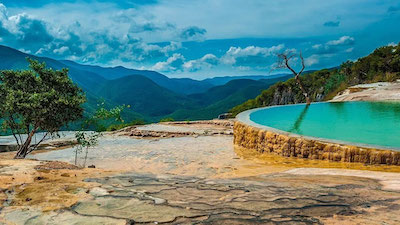
Boil the water. It is believed that it was a sacred place of the ancient Zapotecs. The fossilized waterfalls stand out: one 30 m high and the other 12, formed by carbonated water that falls from springs located at the top of the rocks. The spring area that gives rise to this has been used to create a large pool that has become a natural spa for its thermal waters and has an incredible view. The water temperature fluctuates between 22 and 25ºC. Here is a complex irrigation system and terraces built by the Zapotecs some 2,500 years ago. Currently, it has bathrooms, dressing rooms, palapas and small eating establishments, as well as cabins.

Monte Albán - Zaachila directions
Monte Alban. Former capital of the Zapotecs, later occupied by the Mixtecs until shortly before the arrival of the Spanish. It is part of the list of UNESCO World Heritage Sites. At its peak, Monte Albán covered an area of 40 km2 and had a population of approximately 40,000 inhabitants. On an immense esplanade at 1,940 meters above sea level, is this area formed by a large rectangular Plaza surrounded by palaces, temples, shrines, ball court and tombs.
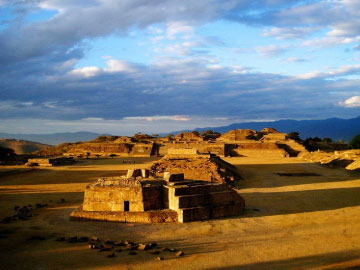
The Danzantes Building stands out, covered with numerous stelae in which there are representations of characters in eccentric positions; So far, about 300 stelae of "Danzantes" have been found, some exhibited in the museum. Building J is one of the most interesting due to its orientation and shape, it is believed that it was used for astronomical observations. The Palace, with a central staircase and thirteen rooms around a central courtyard, was occupied by the noble or priestly class. System IV is a ceremonial complex consisting of a temple, a patio and a shrine with characteristics similar to those found in Teotihuacán. Along with this System is the Monte Alban -Zaachila Estela 18 Route, which at 5.80 meters high is the highest in Monte Alban and is also one of the oldest; in it the phenomenon of the summer and winter solstice is represented.
The South Platform has a majestic 40 meter wide staircase that ascends 15 meters to reach the huge platform (140 m. North-south x 108 m. East-west) where two temples are located; in the corners are stelae with zoomorphic figures and glyphs. Tomb No.7 was discovered in 1932 and a burial was found with a rich amount of offerings that are exhibited in the Regional Museum of Oaxaca, it has a Site Museum, bookstore and a cafeteria. The museum is very modern and has the exhibition of pieces from the area and the history of the discovery and exploration of Monte Albán. Schedule: Monday to Sunday from 08:00 to 17:00.
Atzompa. Pottery has been its most important activity since its founding, which goes back to the days of Monte Alban. In the House of Handicrafts, you can see the making of beautiful pieces of natural clay and green glazed clay, a technique that characterizes the Atzompa pieces. In 2012, the archaeological site called Monumental Ensemble of Atzompa was inaugurated, located at the top of Cerro El Bonete. The archaeological site was a satellite city of Monte Albán and was inhabited from 250 to 900 AD. It has three ball game courts, one of them 45 meters long, which makes it the largest in the area. Other important structures on the site are the Casa de Oriente and the Casa de los Altares.

Arrazola. In this place, the ingenuity of the artisans is reflected in the carvings of the copal wood, creating a fantastic zoology that is exhibited and sold in the artisans' own houses under the name of alebrijes.
Cuilápam de Guerrero. Majestic 16th century Dominican convent complex where the Open Chapel, the unfinished basilical church and the Ex-convent stand out. The frescoes of the Church stand out. Here General Vicente Guerrero was shot. Currently, the ex-convent is used as a museum and church. Schedule: Daily from 10:00 a.m. to 6:00 p.m..
Zaachila. It reached its peak between 1100 and 1521 AD and was the last capital of the Zapotec empire, although by the time of the conquest evidence suggests that it was in the hands of the Mixtecs. The area has been partially explored and includes a great pyramid and some mounds. The most relevant are Tomb 1 with ornaments of stucco figures that represent feline heads, owls, a human figure covered with the shell of a turtle and snakes; and Tomb 2 where a rich offering with gold objects and precious stones was found. Schedule: Daily from 8:00 a.m. to 5:00 p.m.. The town preserves pre-Hispanic traditions and customs that can be enjoyed in the weekly tianguis on Thursdays that takes place in the central square with a display of color and flavor. It stands out for its black clay pottery and its gastronomic richness. It has a great variety of typical restaurants.

Coyotepec - Ocotlán directions
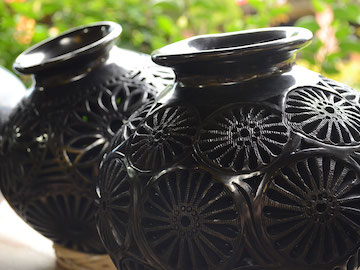
San Bartolo Coyotepec. Ancient Zapotec settlement dating back more than 2,500 years. Its main attraction is the black clay pottery made by local artisans, making pieces of extraordinary beauty, with the technique of openwork and burnishing. This tradition dates back to pre-Hispanic times. There is a beautiful 16th century church, a Museum of Ceramics and the State Museum of Popular Art.
San Martin Ticajete. Its history dates back to 1150 AD when the Zapotecs settled in the region. It is a town dedicated to the making of carved and polychrome wooden animal figures, called alebrijes. You can visit the Temple of San Martín. In April the Alebrije Fair is celebrated.
Saint Thomas Jalieza. It is known as the "Town of Belts" for the artistic way of adorning them. In the center there is a market where you can buy belts, as well as beautiful shawls, huipiles, overcoats and shawls.
Ocotlán de Morelos. One of its main attractions is the "tianguis" on Fridays. The red clay pottery, cutlery, apaxtles and rustic kitchen utensils stand out.
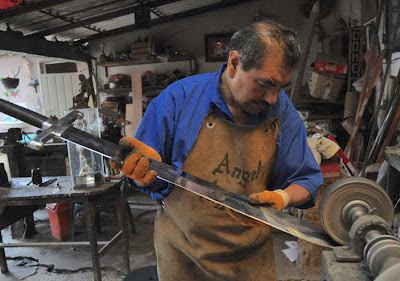
In the town you can visit the Temple and Ex Convent of Santo Domingo de Guzmán. The complex was built in various stages between the 16th and 19th centuries; In the church you can see the statues of saints from the colonial era and the monastery was restored and turned into a museum that exhibits works by Rodolfo Morales, a famous artist from this town, crafts from the region and art from the 16th and 17th centuries. The Casa de Rodolfo Morales, an 18th century mansion converted into a House of Culture, exhibits some of the artist's works and has an open-air theater. The Municipal Palace also has some murals painted by Rodolfo Morales. Mezcal is one of the best in the Valleys of Oaxaca.
In the heat of the forge and in the midst of the rhythmic and incessant blow of the marro, it is closely known how the ocoteco artisans turn crude metal into beautiful and sharp blades, tempered by fire. Swords, knives, letter openers, daggers and sabers, bear inscriptions of names or popular sayings, and their polished handles, made of leather, bone, bronze or horn, show the painstaking meticulousness of this art, centennial legacy of Toledo steel. traditionally used for the manufacture of swords and other weapons of war.

San Andrés Huayapam - Capulálpam - Sierra Juárez Route
Ixtlán de Juárez. The town is surrounded by mountainous landscapes and is characterized by its architectural beauty. The Temple of Santo Tomás Apóstol stands out, built in the 18th century in a Churrigueresque style. It has become an ecotourism center, where you can practice various extreme sports and admire the more than 500 species of birds in the region. Interesting wooden crafts and clay utensils are made in the town. Mountain biking and horse riding are possible in the surrounding area.
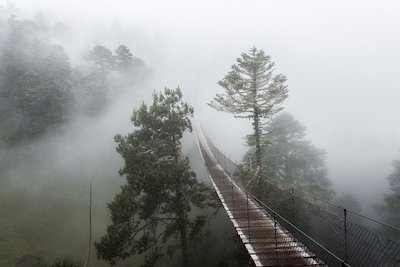
Sierra de Juárez. It has an area of approximately 1,700 km2 of high mountains and deep ravines, separating the Central Valleys of Oaxaca from the coastal plain of the Gulf of Mexico. It is one of the richest areas in plant and animal species at the national level, and has a diversity of ecosystems. It has 6,000 plant species, 400 of birds and 350 of butterflies. These beautiful and spectacular natural areas are excellent for various activities such as hiking, mountain biking, horseback riding, flora and fauna observation, and zip lining. In the area you can also find centers that offer traditional medicine in temazcal, clean with herbs from the mountain and massages with mud. Here you can buy delicious canned fruits such as apple, tejocote and peach.
There are several tours through the Sierra. In La Nevería, you can go horseback riding or cycling to two panoramic viewpoints. Llano Grande, one of the cleanest communities in the country, ideal for mountain biking. Santa Martha Latuvi, with spectacular landscapes that can be seen on walks, on horseback or by bicycle, the specialty of the place is trout stuffed with mushrooms. There is a route that connects this town with San Miguel Amatlán, which runs through a beautiful forest that is believed to be part of one of the roads that connected the Zapotec cities. Santa Catarina Lachatao, with a beautiful wooded setting. All these places have local guides, cabins and camping areas.
San Andrés Huayapam. In this picturesque town you can enjoy its peaceful atmosphere strolling through its cobbled streets and enjoying its mountainous landscape. Here is a 16th century temple built by Dominican monks. Inside you can admire beautiful paintings such as "The Last Supper" and splendid altarpieces, a beautiful organ from the 18th century also stands out. Nearby is a small dam and several waterfalls. Cradle of the thousand-year-old drink of the gods "El Tejate", a drink made from roasted corn flour, fermented cocoa beans, mamey seeds and cocoa flower, also known as rosita de cacao; With all these ingredients, a paste is made that is mixed with water. It is served cold in red clay gourds making sure that each one has enough foam on top. Every year in April the Tejate fair is celebrated.
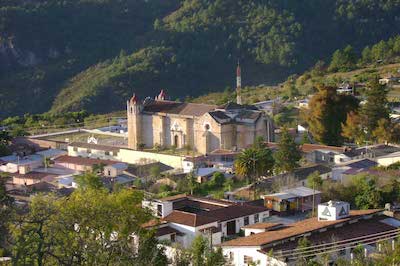
Capulálpam de Méndez. It has been named a Magical Town, since through the years it has preserved its traditions and customs reflected in its gastronomy, crafts and music. Its streets are cobbled and adapt to the irregularities of the topography of the place. The architecture of the town is characterized by the use of adobe, wood, tile and yellow quarry. Here is the Temple of San Mateo Apóstol, a 16th century building in which baroque and neoclassical styles are combined. They have a simple façade and inside are magnificent altarpieces from the 17th and 18th centuries. Woolen textiles and embroidered dresses are produced in the town that can be purchased at the municipal market. You can also visit the toy and art gallery. There is a center for Traditional Medicine, where “clean”, temazcal baths and natural medicines are offered, as well as a herbal pharmacy that offers courses on various medicinal plants.
From September 11 to 22, the annual fair in honor of San Mateo Apóstol is held with the traditional calenda, jaripeos and fireworks. It is surrounded by natural beauties so you can take pleasant walks and bike rides and admire the wooded landscape of pine and oak, as well as the colorful bromeliads and the large number of birds in the region. You can visit "Los Sabinos" with tall and old trees; "El Calvario", viewpoint with a spectacular panoramic view of the town; "La Cueva del Arroyo" with its capricious figures formed over time; the "Los Molinos" Recreational Center with a 100 meter long zip line that crosses the river from a height of 30 meters; and the "Cerro Pelado", where you can walk through an old path or "royal road", used in colonial times to communicate with other towns in the mountains.

Mixtec Route (Route of the Dominicans)
San José el Mogote. It shows archaeological evidence of early occupation, it is believed to be the first stone city in Mesoamerica, dating back to 1,500 BC. Trade with the Olmec culture is evident from the pottery and other objects found at the site. El Mogote was one of the most important urban centers in the Central Valleys of Oaxaca before the founding of Monte Albán. The archaeological zone is made up of a square surrounded by numerous pyramidal platforms. There is a community museum in a restored hacienda with interesting archaeological pieces from the site and the history of the hacienda.
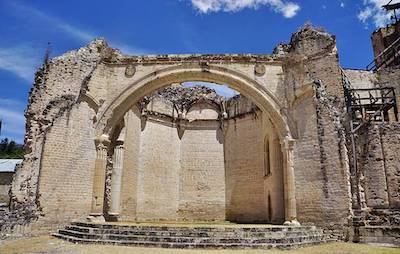
San Juan Bautista Coixtlahuaca. The Temple and Ex-Convent of San Juan Bautista stands out, a beautiful Dominican complex completed in 1576. It consists of a temple, a cloister, an open chapel and an atrium, making up one of the most peculiar examples of New Spain art and architecture of the century. XVI. The altarpieces inside are in the Churrigueresque style and a beautiful main altar with gold filigree. The open chapel displays Mixtec elements such as snakes and eagles.
Villa de Etla. It has a beautiful complex built by Dominican friars with green quarry in 1636, it consists of atrium, temple and convent.
Tlaxiaco. Here you can visit the Ex-Convent of Nuestra Señora de la Asunción dating from 1548, following as a model the conventual complex of Yanhuitlán, vaulted and with a main facade of great proportions. Inside there are five elegant chandeliers. In the main square you can see a beautiful clock and you should not miss its colorful market.
Saint Peter and Saint Paul Teposcolula. The Dominicans settled here in 1541, starting shortly after the construction of a fabulous complex with a magnificent open chapel that is one of the most important works of the 16th century in New Spain. Inside the temple some works by the painters Andrés de la Concha and Andrés Pereyns are still preserved. The monastery is a small museum with some restored cells that surround a beautiful garden. The large atrium was built in order to indoctrinate the Mixtecs in large numbers at the same time. In front of the church, the Spanish built in 1560 the Casa de la Cacica, for a Mixtec leader; Its construction combines pre-Hispanic and colonial elements and currently houses a library. Two km away is the archaeological site of Pueblo Viejo (Yucundaa) on a mountain that rises 220 meters. The site was one of the most important Mixtec chiefdoms between 1000 and 1550 AD

Santo Domingo Yanhuitlán. In colonial times it was an important commercial center. The Temple and Ex-Convent of Santo Domingo, constitutes one of the most outstanding examples of New Spain architecture from the 16th century. The enormous construction was erected partly on a huge pre-Hispanic platform and partly on embankments and its roof rises almost 25 meters. Although some modifications were made in the 18th century, it preserves the original paintings and sculptures, among which the main altarpiece from the 16th century stands out, made by the Sevillian painter Andrés de la Concha. The monumental tubular organ decorated with interlacing and golden plant elements stands out. In what was the convent, the Regional Museum of the Ex-Convent of Santo Domingo Yanhuitlán was installed, which presents an interesting exhibition of sacred art and the facsimile of the Yanhuitlán codex. Schedule: Tuesday to Sunday from 9:00 a.m. to 5:00 p.m..

Mezcal Route
From the Nahuatl mexcalli, 'cooked maguey leaves', is an alcoholic beverage native to the state of Oaxaca (Mexico), made from the distillation of the fermented juice of various species of agave. Mezcal can vary, depending on the species of agave or maguey used for its production, and for the fruits or herbs added during its fermentation, as well as for the distillation process used, creating subtypes such as: worm, tobalá, breast, white, miner, lemon verbena, scorpion, among others.
You can also find Mezcal Creams, created by processing agave honey through double distillation, which gives it a sweet flavor and can be combined with a wide variety of products and thus obtain: coffee, passion fruit, nanche cream, mango, coconut, strawberry, piña colada, cappuccino, passion fruit etc. The Mezcal Route includes the Sierra Sur, a mountainous region, where the forest wealth and the coffee production are important.
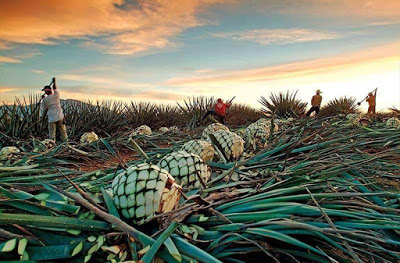
Matatlan. It is one of the most important mezcal producers in the state. There are a large number of mezcal factories and outlets, it is known as the “Mezcal Capital of the World”. You can also visit the temple of Santiago Apóstol erected in the seventeenth century, which has a wall and atrial cross, main portal and two towers with bell tower. To the north of the municipal seat there is an archaeological zone that has not yet been explored. Here the Annual Mezcal Fair takes place.
Tlacolula. It has one of the most beautiful chapels in Oaxaca. The Church of "La Asunción de Nuestra Señora" with an original baroque style was built in the 16th century. Its Sunday market is also famous with an almost ritual and mystical atmosphere. Tlacolula is also famous for its excellent bread, its exquisite mezcal and its tasty barbecue
Yautepec. In addition to savoring the mezcal of the region, you can also buy some of its beautiful textiles, clay pottery or various palm handicrafts.
Sola de Vega. Also famous for its mezcal, huipiles and different pieces of pottery can be purchased.
Ocotlan. In the town is located the Temple and Ex-convent of Santo Domingo de Guzmán, its facade is ornamented with plant decoration. Inside, the chapel of the Lord of the Sacristy stands out, decorated with neoclassical details. Other attractions are: the City Hall building built in 1913 and a community museum located in the old Dominican convent.
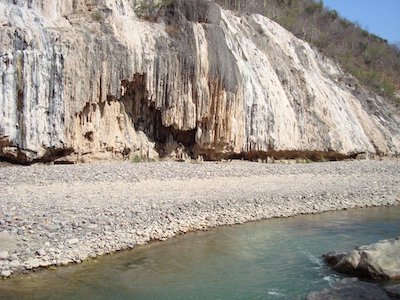
Salina Blanca. Its name is due to the fact that in the area there are salty water runoff that comes from the subsoil and due to the steep slope of the hill, waterfalls of living petrified salt have formed that can be seen from the banks of the Quiechapa River. 150 mts. Downstream of the Quiechapa there are springs from which water with a high mineral content gushes from the interior of the mountain and that form small replicas of the “Salina Blanca” area, in that same scenario there are ideal spaces for camping, climbing and enjoy nature.
Ejutla. Among its most important monuments is the Temple of Santa María de la Natividad with gold altarpieces and images in high-value paintings, as well as the paintings that are found throughout the interior of the temple. You can also visit the portals that surround the city center.
Miahuatlan. Here you can visit the parish temple, the pilaster, the municipal palace, the archaeological zone, the Yoolveo hill, the Nogales hill, the slaughterhouse hill and the central garden.
Zimatlan. Zapotec population whose history begins in pre-Hispanic times. Famous for the production of mezcal and amaranth.

More Tourist Attractions in Oaxaca
The vast Oaxacan cuisine is distinguished by its tradition and the use of regional ingredients. Not for nothing has it positioned itself as the Best Tourist City in the World and the Best Gourmet Destination. In the presentation of the 2021 edition of The Mexico Gastronomic Guide "The Great Restaurants of Mexico" 278 restaurants located throughout the Mexican Republic were recognized, on this occasion, there were 16 Oaxacan restaurants that were placed in the list .
Oaxaca is famous throughout the world for its archaeological sites and the history they keep. Discover Monte Alban, Mitla, Yagul and more of these remote sites, which have made Oaxaca a World Heritage city, according to Unesco. The original Zapotec and Mixtec peoples of Oaxaca lived in the cities and religious centers of the valley of this city until the time of Spanish colonization. Today, there are still vestiges of these towns and places where you can meet them.
An ideal space for Alternative Tourism, Oaxaca offers activities such as walking, mountain biking, rappelling, climbing, zip-lining, horseback riding, observation of flora and fauna and more, in close contact with nature. The visitor can also witness the various aspects of local life, savor the gastronomy and enjoy the warmth of its people, as well as an offer of accommodation in hotels, ecotourism cabins, local houses or excellent camping areas. In its varied geography, it brings together not only a vast biodiversity, considered among the largest in the world, but also insurmountable cultural and ethnic riches, and the most different and beautiful natural settings.
Oaxaca's culinary tradition is extraordinary and deeply rooted. There are fourteen different ethnic groups, with their own dishes. It is an area of incomparable wealth for the tourist interested in gastronomy, ethnology and culture in general. Oaxaca is the land of mezcal, tlayudas and the famous seven moles. You have to dedicate several days to it. Oaxacan gastronomy is one of the cultural manifestations that identify and define its people, due to its variety, richness and complexity that have been preserved through the centuries. The best way to enjoy Oaxacan food is by tasting it, from the “strong” dishes that are used to enjoying at lunchtime; like the traditional Oaxacan snacks that can be enjoyed at any time of the day.
In Oaxaca we are proud to have 5 communities that have been awarded the title of Magic Towns of Mexico, a Magic Town is a town that has symbolic attributes, legends, history, transcendent events, everyday life, in short magic that they emanate in each of their socio-cultural manifestations, and that today mean a great opportunity for tourist use. The Magical Towns Program contributes to revalue a group of populations in the country that have always been in the collective imagination of the nation as a whole and that represent fresh and different alternatives for national and foreign visitors.
In the state of Oaxaca there are many customs and traditions throughout the year, and within the state, said that they have the same purpose of celebration but with different things, in fact from one region to another or even more from one town to another, the Customs vary for perhaps details but that is what makes them authentic. Oaxaca has deep-rooted customs and traditions. All the holidays are celebrated, the profane and the religious ones. The festival calendar is extensive due to the diversity of ethnic groups, which they still conserve.
Crafts in Oaxaca are so varied and of such good quality that they have become a tourist attraction. The ancestral traditions, the diversity in the ethnic groups, as well as the richness in the history of the state have been manifested in the great diversity of creations of more than half a million artisans that are registered in Oaxaca. In the center of the state is the City of Oaxaca, a fascinating and hospitable capital in whose surroundings various towns are located, each with its own personality and craft tradition, accompanied by their respective customs, festivals and dishes.
Monte Albán is the most important archaeological zone of the Oaxacan entity, of unique regional importance due to the religious, political and economic control that the Zapotec state exercised over the population of the Valley of Oaxaca for more than thirteen centuries. It has been named by UNESCO as Cultural Heritage of Humanity along with the city of Oaxaca on December 11, 1987. The heritage of the Zapotec world reaches us through the magnificent archaeological sites designed in the Valley of Oaxaca. Of these, the city of Monte Albán stands out for its enormous importance as an economic, political and religious hub (it was the first urban complex in Mesoamerica); by its extension, almost as big as the current capital of Oaxaca; and for its long life, started around 500 BC and concluded around 850 AD
The name mezcal has its roots in one of the ancient native languages of the area and translates as 'agave (also known as maguey) cooked'. Although pre-Hispanic Oaxaqueños used maguey to make pulque (an undistilled alcoholic beverage), it seems that the real advances in mezcal production occurred when the Spanish arrived in Oaxaca; by bringing with them their knowledge of distillation processes.
Oaxaca City, the state capital, is famous for its architecture and rich cultural traditions. Oaxaca also has a splendid and varied cuisine and a spring climate throughout the year. UNESCO declared the city a Cultural Heritage of Humanity. Oaxaca is the most diverse state in Mexico. It has peaks that reach more than 3,000 meters in height, caverns that are among the deepest in the world, pristine beaches, secluded forests and sunny valleys. Oaxaca is rich in traditions and customs and has the largest ethnic population in Mexico.
The Guelaguetza is an ancient tradition with pre-Hispanic roots related to agricultural ceremonies of gratitude to the gods for the arrival of the rains and the lifting of the harvest at the end of July and is the largest festival in Oaxaca. La Guelaguetza is a celebration of gratitude for the arrival of the rains and the harvests, in which representatives from all regions of the state gather in the capital to share their culture through dances, crafts and food.
The Santo Domingo Cultural Center is a cultural complex that is located in what was one of the most important convents in the colony. It is a large convent in which the Museum of the Cultures of Oaxaca, the Fray Francisco de Burgoa Library and the Ethnobotanical Garden have been established. The Néstor Sánchez Public Newspaper Library is located in a building that is part of the complex but dates from the 19th century. Apart from all these institutions brought together, the Santo Domingo Cultural Center has multipurpose spaces in the former convent, in which temporary exhibitions, conferences, courses, book presentations and concerts are held, among many other activities.
The beaches of the coast of the state of Oaxaca are among the most beautiful and complete in Mexico, thanks to a developing tourist infrastructure and the rich gastronomy of the Pacific. Along the 533 kilometers of coastline, the beaches of Oaxaca offer a wide variety of activities for lovers of water sports: snorkeling, diving, sport fishing, surfing, among others ... there is something for everyone!
Places such as Puerto Escondido, Mazunte, Zipolite, Carrizalillo, Puerto Ángel or the beaches of Huatulco will offer you the possibility of contemplating beautiful sunsets, delighting in intense adventure tourism or witnessing the exciting release of newborn turtles.

Guided Tours in Oaxaca



